
Ceramothamnion pacificum
Hairy Pottery Seaweed
29 April 2025
Point Holmes, Strait of Georgia, B.C. Canada
Tide: receding to a 0.2 foot low at 13:38 PDT (measured at Little River Tidal Station)
Weather: Mix of sun and cloud, wind N 10 – 15 km/hour, sea rippled, humidity 55%, 13 ˚C.
Moon: Waxing Crescent (5.9%, 2 days); Next phase, First Quarter, 4 May 2025 at 6:51 am PST; Previous Phase, New Moon, 27 April 2025 at 12:31 pm PST.
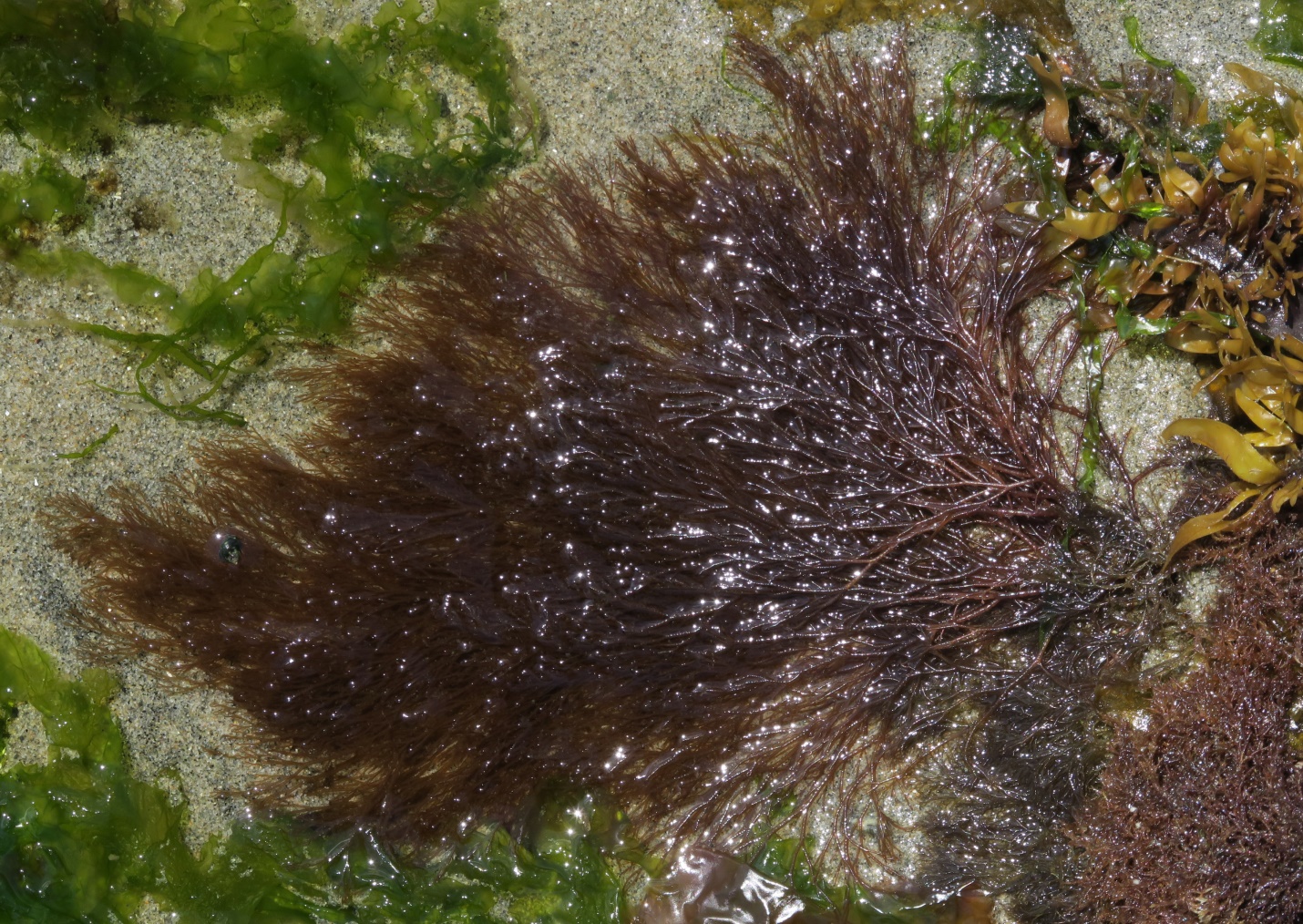
Figure 1: Splayed out and both partially immersed and partially exposed, this is a prime example of Ceramothamnion pacificum. There is a look to it that includes certain traits including that it looks flattened, pale red, somewhat sparkly, and having an overall “reaching out” aspect that extends all the way to its tiny forcipate-tipped branch ends. Point Holmes, Strait of Georgia, B.C., Canada. April 29, 2025. Photo ID 27767 ©Seaweedwhisperings.com
Person 1:
Likes to lie flat and relax (when tide is out).
Sparkles in sunlight.
Has pincers to snap at intruders that might want to disturb it.
Otherwise calm much of the time.
Looking close up with backlight it has a banded appearance, consisting of dark material alternating with pale translucent sections.
From a distance it looks more as though it has sparkling dots alternating with darker sections.
Perhaps this seaweed has an alternating energy from very active to slow and calm.
Alternations are deliberate and confident, not a result of indecision but the result of a clear choice.
Looks smooth and cartilaginous but feels a bit rough to the touch.
Maybe has a bristly personality – that roughness.
Could be irritated or aggravated…?
Has the capacity to switch out of calm, peaceful and polite and into “just go”. Just “going” for them has a palpable intensity and determination to it.
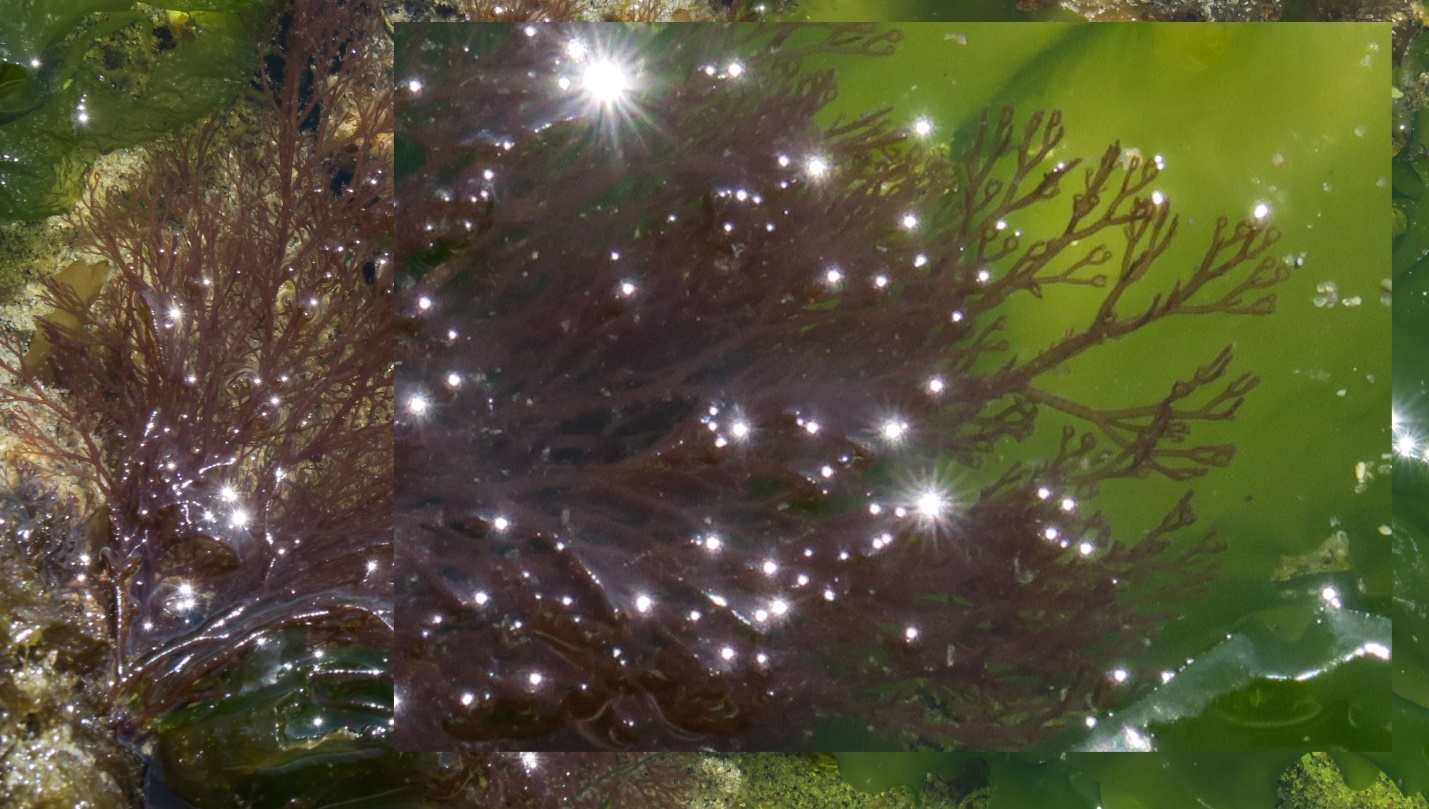
Figure 2: The inset to this photo is magnified many times life size. On one or two of the outermost right branches you can see not only the banded coloration and forcipate branch tips, but also some of the tiny ‘hairs’ that give rise to the common name of this red alga – Hairy Pottery Seaweed. Point Holmes, Strait of Georgia, B.C., Canada. April 29, 2025. Photo ID 27768 ©Seaweedwhisperings.com
Person 2:
Today we arrived at Point Holmes (a small area of the sea coast that we love for finding many diverse types of seaweed) and it was to be the lowest springtime tide we’ve ever managed to enjoy here. The tide was falling to a low of 0.2 feet and much of the beach, cobbles, sand, and the conglomerate rock outcroppings were already exposed and bared to view when we arrived.
Close to the edge of the retreating sea, there was an area of sand covered cobbles whose peaks were mainly out of the water, and due to the bumpy cobble underlay there were also dips that created many small pools of adjacent seawater. These pools were warming; they were shallow and today the sun was fully present and having its thermal impact.
Here we encountered many clusters of Ceramothamnion pacificum. This red alga always seems to grow in groupings of thin, rather delicate looking strands. They fan out in a tidy way from their common holdfast point, and their red to rose-red overall color is often highlighted by some of the branches catching the light so as to sparkle. It can look like a string of tiny beads, one lit, one not, one lit, one not, one lit, one not…, and the intervals are evenly or tidily spaced. It gives a sparkle to the look of this seaweed that is quite attractive, if you happen to catch it from the right angle.
We wanted to take an overview of the area before settling in on any one interaction, and so we moved on to explore several of the numerous other macroalgae species revealed here today. After an hour and half of taking in all of this – this almost overwhelming display of seaweed exuberance, we decided to see if Ceramothamnion pacificum would be willing to share some of its wisdom with us. I tried to settle and connect with some nearby groupings of Ceramothamnion and it wasn’t right. So I moved on to another grouping, and then another, and another; eventually I wandered back to some of the very first ones I’d found this day. It was notable how I couldn’t truly ‘settle’ with many of the groupings, and only felt more of a connection when I returned to the first ones I’d encountered. I think this says something about the energy of this seaweed. It either attracts, or not at all; it connects or doesn’t, and there is nothing much in between. It shows an attractive sparkle and some pretty rose red coloring with its tidy groupings of branching stems, or it is closed off, shut down, appearing almost as if the life has faded right out of it or has significantly withdrawn for some reason.
Getting a closer look you can see the pincer tips that are a part of this seaweed’s morphology. They are tiny, but are just visible with the naked eye. This kind of branch tip is interesting. What is its purpose? The pincers give a neat and also rather “fanciful-looking” termination to the branches which are already interesting in that they are not simply red in color – they are actually banded with red segments alternating regularly with pale. These differently colored sections are all linked up like beads on a thread. The pincers at the branch tips look as if they could clasp or grip something, and do so with accuracy. Rather like the thumb and forefinger on a human hand and positioned at the end of this seaweed’s branches, the pincers look like they are reaching out, and that they can and will grasp certain things. Perhaps these pincers indicate a type of striving that accompanies ambitions that are detailed and that need to be carried out with accuracy, exactness and precision.
And if you touch the stems, they feel rather more wiry than you might expect from looks alone, and there is a ‘raspy’ or slightly rough texture to them. I imagine that each of the little groupings of red cells that surround the central axes creates a thicker section and this becomes a small bump that is repeated, over and over, along the entire length of the stem and right out to the forcipate tips. A series of bumps that could possibly serve to toughen up the stem? Surely they’re not simply decorative, these rings of red cells! I think there is a ‘toughness’ to this seaweed, or at the very least a “thick skin” quality that is not outwardly obvious, but that is present none the less. Ceramothamnion doesn’t present itself as tough, but it certainly does have this quality if it needs to draw upon it.
Ah..., Ceramothamnion may not ‘display’ their toughness, but they cannot hide the way their stems and branches behave – these are all really remarkably untangled and orderly. So the groupings of very small cortical cells that ring this seaweed’s every part with bands of red, these must toughen them and STIFFEN them. In an animal we could think of this as a muscle or some kind of exoskeleton; in a seaweed no such tissue is possible but these red cortical cells do a similar job. And are they a bit stiff in the interactions, too? Emotionally a bit reserved – I think this may be true.
I also wonder if this raspy and rough texture can be experienced in how they come across to others; possibly instead of being friendly and outgoing, they can flip into being more irritated and even petulant. They might be cross and snappy towards others who they experience as disruptive or interfering with their activities and lines of thought. At times it seems they could silently sulk and this certainly would drain any light from their outward presentation.
This seaweed lays in a tidy arrangement in shallow water. It looks settled, both comfortable and quite content. There is no tangling of the groupings of the rather fine stems and I wonder if the individual stems are somehow impervious to attraction towards each other. Perhaps all the sections of red cells that ring the stems create a bit of armor, or at least a type of distancing mechanism? It is as if each stem clearly wants to have their own reach, is determined to make their own way as they experience life, and they won’t allow themselves to get distracted by mixing and mingling with their neighbors.
I looked at synonyms for this quality of “toughness” I experienced with this seaweed. To me that word felt correct, adequate, but also a bit lacking in literary finesse. I think this seaweed’s energy is like that. It is pragmatic, practical, reaches out and dives in with resolve and fortitude once it sets its direction. It also does not spend much effort with its fanciful side or to polish any delicate aspects, yet that side is there in them very much, too. The aspect I return to again is that they can look more intricate and refined than they actually are. That is the look, but the regular rows of cells creating banded coloration along with the delicate pincer tips, these really are quite tough; they exist because they have a purpose and a function that is important to Ceramothamnion. Perhaps Ceramothamnion is not yet ready to both show and act out these very different aspects of themselves at the same time; the best they can do is alternate between them.
Looking closely at the stems in photographs enlarged to many, many times life-sized, the detail of the coloration and bands is revealed. The stems are clear or a translucent whitish color and then neatly spaced all along every millimeter of them there are these rings of groupings of small red cells that encircle the stems. The rings of cells seem to be “added on” to the translucent stem and thus where they occur there is a slight bump, an added thickness due to their presence.
If I look at this arrangement I can think of it as being almost like the vertebrae of many mammals and indeed also the human spine. Almost like the translucent part is the spinal cord or maybe the discs and the red part is the vertebral bone.
The spine for a mammal gives support to the form; we call it the “backbone” and something about the concept of having a strong backbone fits this seaweed. Their energy can have an intensity borne of decided and directed will. They can be earnest and dogged and resolute in their chosen actions. That is the part that doesn’t “show” when you simply look at them; it is the part that is not actively hidden but it is also definitely not advertised or boasted about. Perhaps it is too new to them, too, so they don’t present outright to the world that which they are only newly undertaking.
I thought more about the ‘bumps’ the red rings of cells create along the stems…, along every millimeter of the stems. In a very real sense I think the “road” to their ambitions can be bumpy. It is not a smoothly paved expressway but a potholed gravel road. Perhaps things don’t go smoothly for them for very long, but then they simply pause to regroup, pluck up their courage once more, and determine to carry on – and they can do this over and over again.
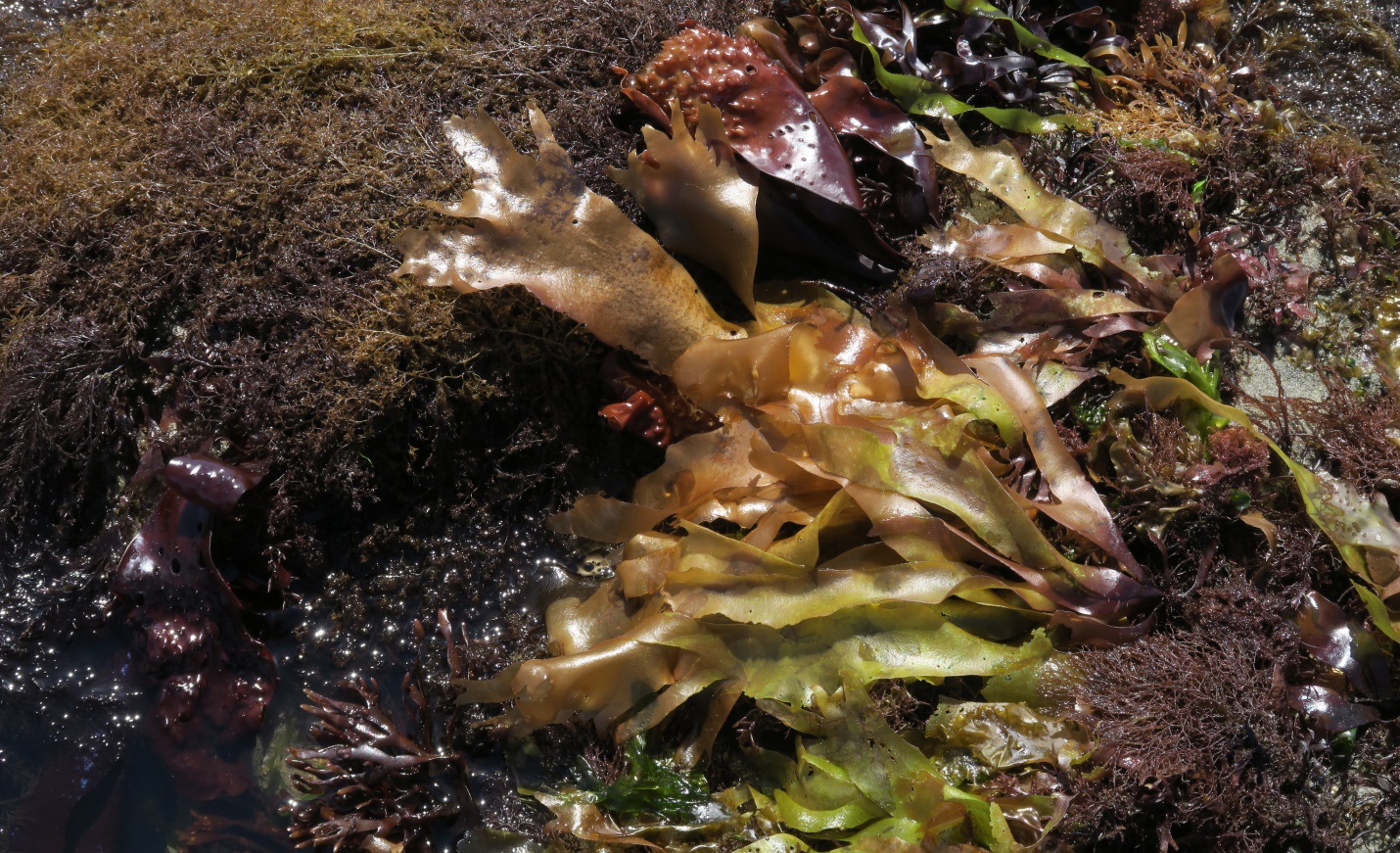
Figure 3: In the mix of marine algae that was revealed near the receding waterline this day at Point Holmes often there was some Ceramothamnion pacificum to be found. In diverse groupings like this it tends to not ‘stand out’ yet it is recognizable if one looks closely. The branching pattern, color, overall size and beaded sparkle look are plainly evident. In this photo it is in the lower right hand corner. Point Holmes, Strait of Georgia, B.C., Canada. April 29, 2025. Photo ID 27769 ©Seaweedwhisperings.com
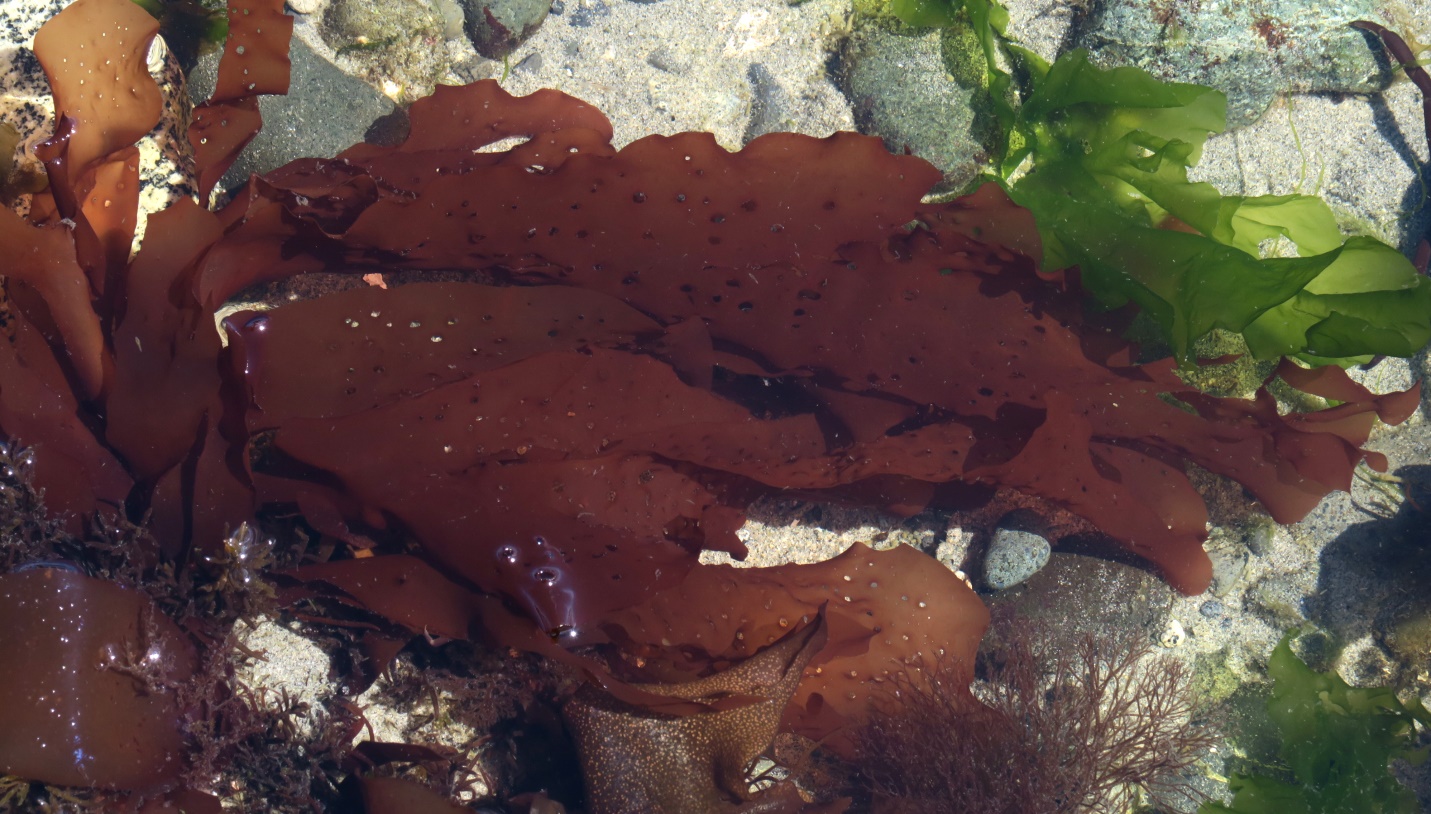
Figure 4: A second example of the “in the mix of marine algae”..., where Ceramothamnion pacificum was also found. In this photo it is on the bottom edge, just to the left of the small patch of green Ulva. We found this seaweed to be very often “around” but not often trying to take “center stage”. Point Holmes, Strait of Georgia, B.C., Canada. April 29, 2025. Photo ID 27770 ©Seaweedwhisperings.com
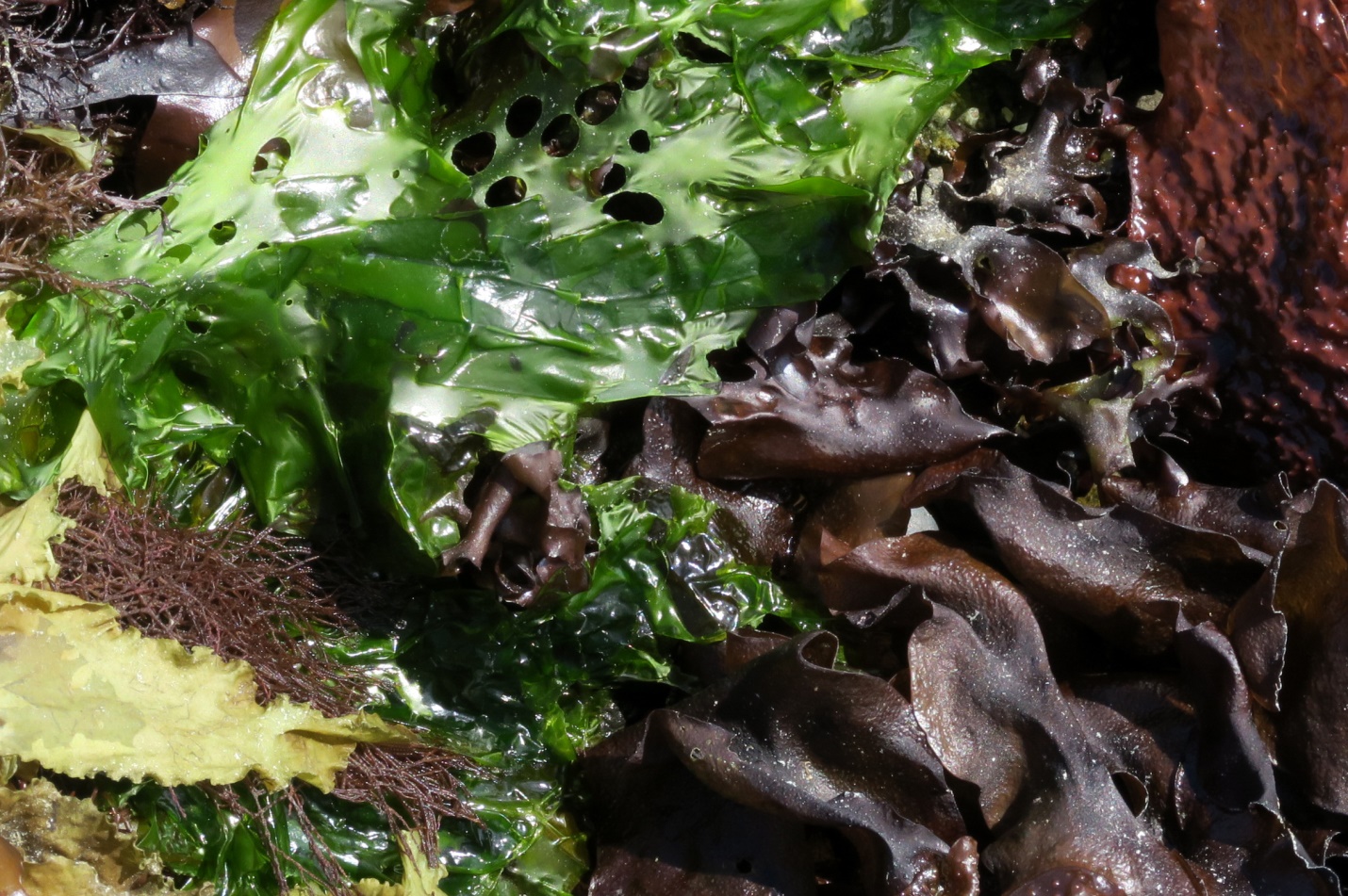
Figure 5: A third example of the “in the mix of marine algae”..., where Ceramothamnion pacificum was also found. By now, you can probably spot it – sandwiched between the yellow bladed alga and the green Ulva fenestrata on the left side of the photo. Point Holmes, Strait of Georgia, B.C., Canada. April 29, 2025. Photo ID 27771 ©Seaweedwhisperings.com
Discussion:
The common name of this seaweed has not held much “meaning” for us. Hairy Pottery Seaweed just hasn’t had relevance to what we could discern, however upon doing research for the Biology & Natural History section of this write up we found magnified photos of this seaweed that reveal tiny, squiggly hair-like filaments protruding from the stem at very irregular intervals. So, it is hairy! And you need a magnifying instrument to perceive that. We could say that the “hairy” aspect is pretty much not in view and that fits with how this seaweed does have hidden or unadvertised qualities. The “Pottery” aspect of the common name remains even more effectively ‘hidden’ and we remain a bit mystified as to the correlation.
The rings of red cells that surround the pale central axis, each one is separated from the previous with a ‘clear’ or uncolored section. Where the red cells exist perhaps there is a special activity going on, and could their presence indicate a kind of focus or concentration of activity that is happily shed in the ‘clear’ sections along the stem? Do they appreciate “taking a break” from the activity or focus of the red rings to enjoy the calm of the in-between sections? One thing is certain, Ceramothamnion itself has decided it likes both – the red and the clear, the rimmed with cells parts and the naked sections, too.
Perhaps one of this seaweed’s strengths is its recognition that the two very different aspects are both useful. Both have different and necessary traits that equip them better to skillfully navigate life with the type of agile dexterity they prefer. And just possibly the biggest difference in this seaweed is not that it employs these different ‘presentations’ but that it switches them up very regularly. There’s a short phase of red, then a short phase of uncolored, followed by another short phase of red and so on. Doing this change up so often perhaps gives them an agility that is steadily fueled from two very different energies.
We found the concepts of hidden or unadvertised in this seaweed contrasted with the ‘sparkle’ that can also be observed about them. However, to gain the ‘sparkle’ impression, one must be looking at Ceramothamnion from a certain angle; otherwise it can be missed entirely. Something about the total energy of this seaweed requires a bit more ‘refinement’ of observation to be truly ‘grasped’. Yes, that sums it up well.
Upon review of a large collection of photographs of this seaweed for inclusion in this document, an observation became clear. Ceramothamnion pacificum is often present in the mix of marine algae in the low intertidal zone and it is recognizable if you observe carefully, but it also seems very happy to not stand out. This serves them; they don’t want their weaknesses to be revealed. It seems that this seaweed has partly got their strengths worked out – the red rings, but they also have their unformed and still developing parts – the translucent sections, and these areas are where they can do the most growth but are also where they are also the most vulnerable.
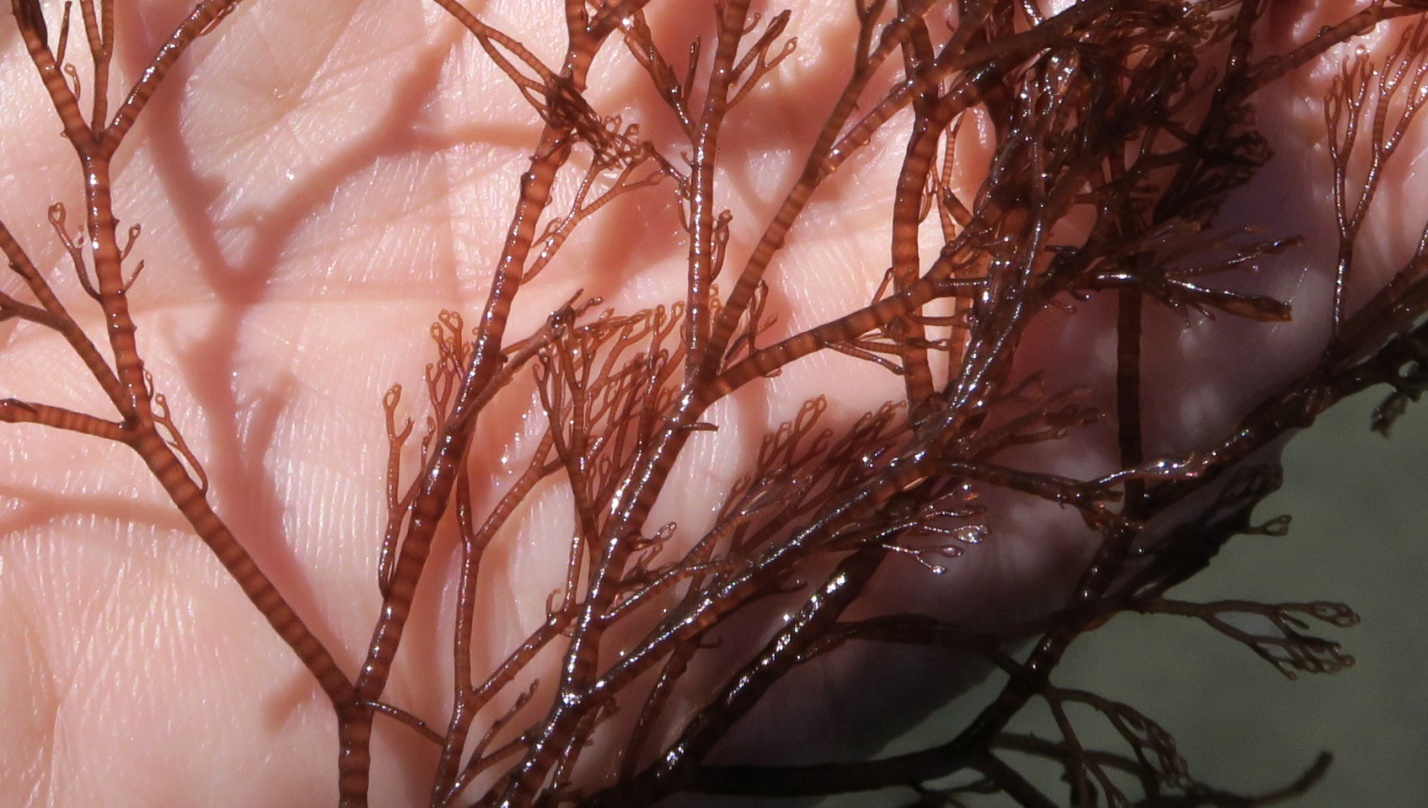
Figure 6: A ‘drift’ specimen is held in hand to better reveal details. The main axes show the banded coloration and their slight bumpiness. Many pairs of tiny pincer branch tips are also visible. Little Qualicum River Estuary, Strait of Georgia, B.C., Canada. April 16, 2025. Photo ID 27772 ©Seaweedwhisperings.com
Biology & Natural History Information:
Description:
A delicate looking red alga, Ceramothamnion pacificum grows to about 18cm long. It is irregular or dichotomously branched, with paired branch tips that are forcipate (resembling crab pincers). Short proliferous branches often present along the main axes. Small red colored cells cover the large central axial cell in regular formation creating a dark and light banding pattern to the thallus. This banding pattern can be most easily discerned when the seaweed is held up to light, but it can also be discerned by the way it reflects light along its surface.
Habitat:
This species grows on rock and epiphytically on other macro algae in the mid to low intertidal and subtidal to a depth of 10 meters. It can be found commonly in shallow tide pools and other sites of protected to semi exposed-habitats.
Pacific Coast Distribution:
Alaska Peninsula, Alaska, and south to Baja California, Mexico.
Remarks:
There are several Ceramium species in the Pacific Northwest; Ceramothamnion pacificum is one of the most easily encountered. Several others are only subtidal, or are significantly smaller in overall size.
Classification:
Phylum: Rhodophyta
Subphylum: Eurhodophytina
Class: Florideophyceae
Subclass: Rhodymeniophycidae
Order: Ceramiales
Family: Ceramiaceae
Genus: Ceramothamnion
Species: Ceramothamnion pacificum (Collins) M.J.Wynne & C.W.Schneider 2023
Former name(s):
Ceramium rubum var. pacificum; Ceramium pacificum; Stirkia pacifica.
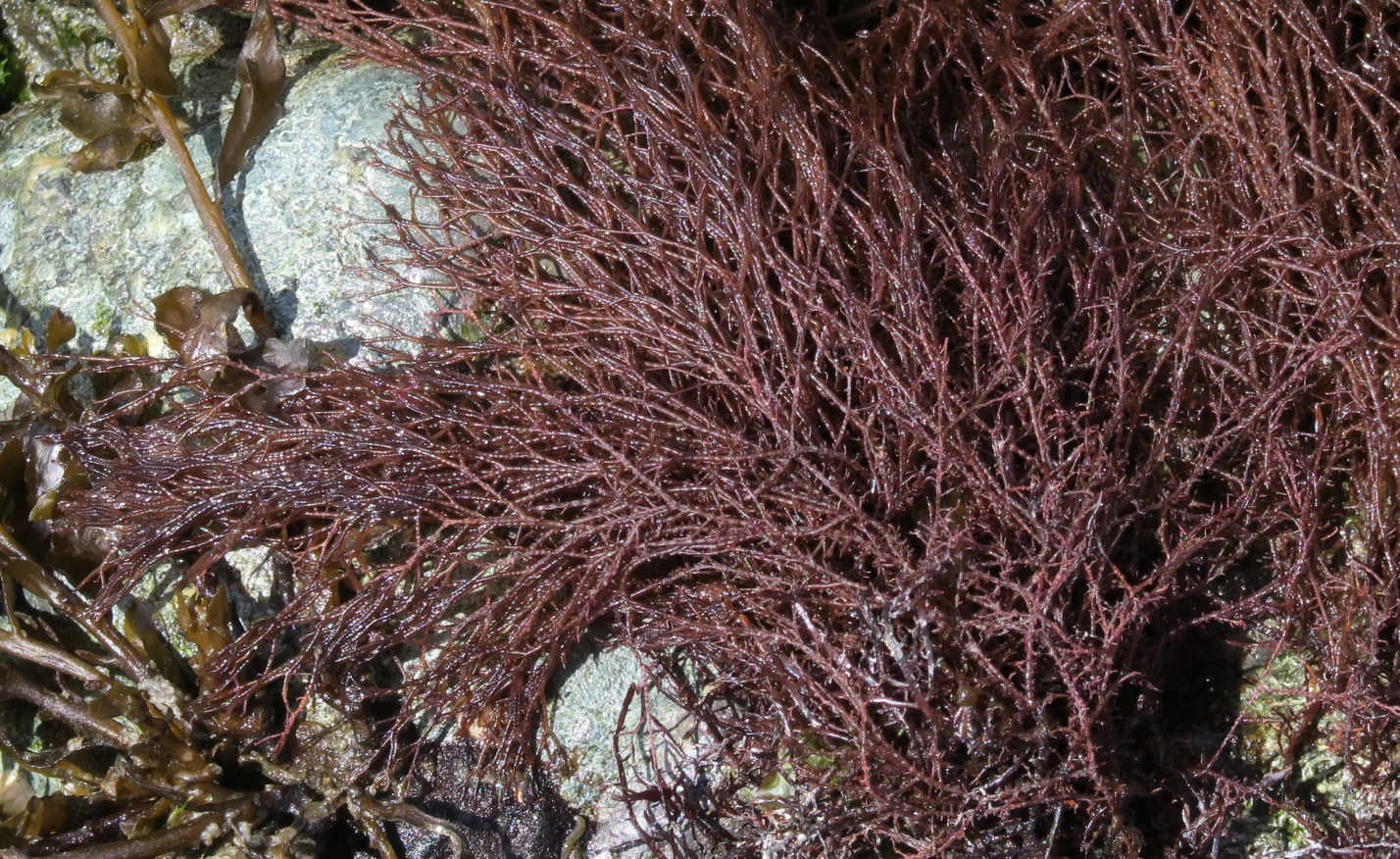
Figure 7: This individual has been fully exposed at low tide and looks a bit impatient for the return tide. Its form is a bit confused because it is lying atop 2 or 3 other species of red alga, but this photo shows the sparkle that can often occur. We thought of it as looking like strings of tiny beads, one lit, one dark, one lit, one dark. Point Holmes, Strait of Georgia, B.C., Canada. April 29, 2025. Photo ID 27773 ©Seaweedwhisperings.com
![]()